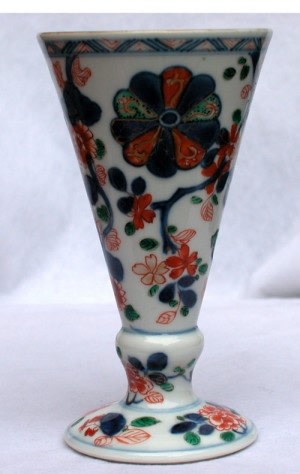Of European glass form cone shaped on a knopped stem and slightly raised convex foot, painted in underglaze blue, famille verte enamels and gilt after the Imari style with, on each side, a mons roundel and trailing flowering tendrils, the rim with a band of cross hatch work in underglaze blue and iron red, the foot and the knopped stem with further trailing tendrils, knop and foot with narrow bands of incised underglaze blue, the base glazed
Literature
This particular shape of goblet is known as a flute and is a mainly English form dating from the late seventeenth century. For almost identical examples see China for the West, Howard & Ayers, published by Sotheby Parke Bernet, London & New York 1978, plate 119, page 140 and we quote This is a typical European, and possibly English goblet shape from about the last decade of the seventeenth century. A rich source of design in such glasses is the series of designs produced by Messrs. Measey and Greene, London Glass Sellersd, during the latter part of the century for glasses to be made in Venice and in London (Sloane Mss, British Museum). Other examples (with somewhat different designs); Hobson The Later Ceramic Wares of China, pl XLIII. Fig 2; Sothebys, 29 June 1976, lot 284 (which appears to be our one).
Provenance: acquired at Sotheby?s London on 29th June 1976; lot 284 110;

